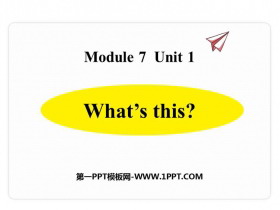


《Language in use》Cartoon stories PPT课件2
Teaching aims
To summarise and consolidate the use of the present perfect , present simple and past simple
To be able to understand learning materials on cartoons
To be able to create one’s own cartoon story
Language practice
He has been popular for over eighty years.
Tintin appeared in China in the 1980s.
Snoopy lives in his own private world.
... ... ...
Observe
Are you familiar with these sentences? They are all from this module.
1. He has been popular for over eighty years.
2. Tintin appeared in China in the 1980s.
3. Snoopy lives in his own private world.
4. We’ve finished our homework.
5. He keeps fighting bad people.
6. We watched Superman yesterday.
7. They look very different, but both of them have won the hearts of young people.
8. They always expect to see more Monkey King cartoons.
9. Fans have bought about 200 million copies of Tintin’s stories in more than fifty languages.
... ... ...
Guessing game
1. to test your sense of observation
2. to test your ability of short-term memory
3. to test your ability of inductive method
Grammar
几种时态的区分
到目前为止,我们己经学过用多种时态来表达行为或状态。本模块重点复习一般现在时、一般过去时和现在完成时。那么,如何区分这三种时态呢?下面我们以一种行为或状 态为例,来看一下它们有什么不同。
请看下面的句子:
I often watch cartoon films.我经常看卡通片。
I watched Spiderman last week.
我上周看了《蜘蛛侠》。
I have already watched Spiderman. I do not want to watch it again.
我已经看过《蜘蛛侠》了,不想再看了。
可以看出,(1)表示经常性、习惯性的动作,所以用一般现在时;(2)表示在过去某个时间发生的行为,用一般过去时;(3)中发生的动作也是在过去,但是没有明确的表 示过去的时间,并且本句强调的是结果,即“现在不想再看了”,所以用的是现在完成时。
... ... ...
一般现在时的用法
1.表示经常或反复发生的动作,常与 always, often, usually, sometimes,once a day, every day等频度时间状语连用。如:
He often goes to school by bus.
他经常坐公交车上学。
We always have supper at 6:30 pm.
我们总是在晚上6点半吃晚饭。
2. 表示现在的状态、特征、能力和感觉。这类动词有be, love,like,hate, want, hope, need, prefer, wish, know, look, sound, taste, have 等。.如:
He is very happy.他很幸福。(表示状态)
She looks like her father.
她看上去像她爸爸。(表示特征)
He knows not only English, but also French.
他不仅懂英语,而且懂法语。(表示能力) How do you like the film?
你觉得这个电影怎么样?(表示感觉)
3. 表示客观真理、科学事实和客观存在。如:
The sun rises in the east.
太阳从东方升起。
Light travels faster than sound.
光速比声速快。
... ... ...
一般过去时的用法
1. 表示过去某一时间发生的动作或存在的状态,常与表示过去的时间状语连用,如 yesterday, last year/month/week, in 2004, three hours ago, two years ago 等。.如:
We helped the farmers with the apple-picking last year.
去年我们性帮农民摘过苹果。
The children enjoyed themselves yesterday.孩子们咋天玩得很高兴。
I finished my homework just now.
我刚刚与完了作业。
2. 表示过去经常或反复发生的动作,也可以用used to do表示,常和often, always等 表示频度
的时间状语连用。如:
Tom often went to work by bus last year.
去年汤姆常常坐公交车去上班。
My father used to smoke.
我父亲过去常常抽烟。
He was always ready to help the people in trouble.
他时刻准备着帮助有困难的人。
3. 有时动作发生的时间不是很清楚,但确实是过去发生的,应当用一般过去时。如:
Who broke the teapot?
谁打碎了茶壶?
Hi, Lucy! I didn't know you were here.
嗨,露西!我不知道你在这儿。
... ... ...
现在完成时的用法
1.强调过去的动作对现在的影响,往往具有因果关系,常与already, yet等副词 连用。如:
She has already bought a computer.
她已经买了 电脑。
He has not found a job yet.
他还没有找到工作。
The Greens have gone to England.
格林一家已经去了英国。
2.表示过去某一动作一直持续至今,常与for, since等引导的时间状语连用。如:
I have been in Beijing for five years.
我已经在北呆了 5 年了。
He has lived here since he moved here.
从他搬到这儿以来就一直住在这里。
3.表示经历或经验,常与ever, never, once,twice, before等副词连用。如:
—Have you ever been to Shanghai?
你去过上海吗?
—I have been there twice.
我去过那里两次了。
... ... ...
中考链接
1. My sister has learnt English______. (2013四川雅安)
A. for twelve years ago
B. since she was four
C. twelve years ago
D. at the age of four
2. Miss Lin _____ a lot of work for the poor area since 2010. (2013北京)
A. does B. did
C. has done D. will do
3. — What does Tom’s uncle do?
— He is a teacher. He ______ physics at a school now.(2013武汉)
A. will teach B. has taught
C. teaches D. taught
4. — Where were you last Saturday?
— I ______ in the Capital Museum.(2012北京)
A. am B. will be
C. was D. have been
... ... ...
1. Complete the conversation with the correct form of the words in brackets.
Daming: Hi. Tony. What are you reading?
Tony: The Adventures of Tintin. It's fantastic.
(1)_____ you ________ (ever read) a Tintin book?
Daming: No, I (2) ___________ (never read) a Tintin story. (3) _____ (be) they popular?
Tony: Yes, they (4) ________ (be) popular for more than eighty years. The first Tintin story (5)_______ (appear) in 1929.
... ... ...
5. Listen again and answer the questions.
1.Why does Betty not think the cartoon is funny at first?
Because she does not understand it at first.
2.Why does Tony think the cartoon is really clever?
Because the police could catch the man in the lift, but he doesn’t. They both just stand there, waiting for the lift to stop!
Tapescript
Tony: (laughing) I think this is really funny!
Betty: Why? I don't get the joke.
Tony: Look! In the first picture, there's a man running away from a policeman.
Betty: But why is he running away? I don't understand.
Tony: Well, he's done something wrong! The policeman wants to catch him.
... ... ...
Homework
Summarise and consolidate the use of the present perfect , present simple and past simple by yourself.
Try your best to master what you have learned in this module and preview the next module.
关键词:《Language in use》教学课件,外研版八年级下册英语课件,八年级英语幻灯片课件下载,《Language in use》PPT课件下载,.ppt格式











